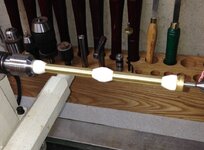LeeR
Member
This may have been covered before, but I did not find it doing a quick search. I use my old pen mandrel with Delrin bushings to sand and finish blanks. After sanding a few brass tubes by hand the other day, I decided there has to be an easier, more uniform way.
I just use the same setup as I do for finishing. I use really fine sandpaper, since they clean up very fast.
I just use the same setup as I do for finishing. I use really fine sandpaper, since they clean up very fast.

